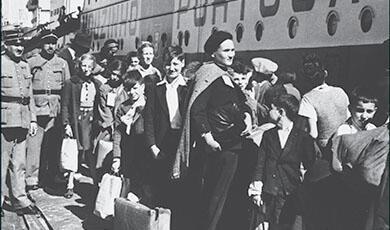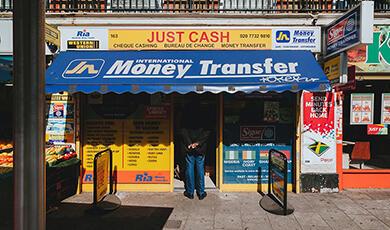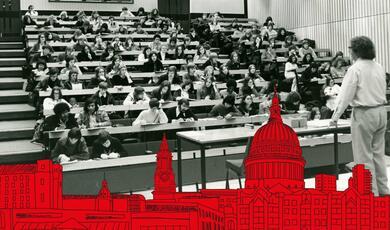Let’s Decolonise the History of Mathematical Proofs!
Share
- Details
- Text
- Audio
- Downloads
- Extra Reading
Joint lectures with the British Society for the History of Mathematics.
What is a “valid mathematical proof”? To inquire into such a hotly debated question we might want to look at how past mathematicians tackled this question.
This lecture will provide examples outside of what has been called a “colonial library”, using in particular Sanskrit sources, to argue that mathematical texts from all over the world contained not only proofs but also many other types of mathematical reasoning whose stories still need to be documented.
This event will focus upon mathematical proofs. The main speaker, Professor Agathe Keller (6pm) will look at decolonisation of the history of proofs, providing examples outside of what has been called a “colonial library”, using, in particular, Sanskrit sources. This will be preceded by shorter presentations by Dr Richard Oosterhoff (4pm) on "The Invention of Mathematical Proof in the Renaissance", and Dr Fenner Tanswell (4.45pm) on "How Mathematical Proofs Are Like Recipes".
Download Text
Let’s Decolonize the History of Mathematical Proofs!
Professor Agathe Keller
19th October 2022
Introduction
Preliminary remarks
A cursory search on the internet, looking for references on the “history of mathematical proofs”, brings up videos, blogs or even scholarly papers, that always tell a variation of the same story
- That we owe the idea of mathematical proof to mathematicians of Greek antiquity, especially to Euclid’s Elements who himself was inspired by Aristotle’s Posterior Analytics.
- That central to the idea of proof is the idea of certitude (and its correlate, rigor);
- Before classical Greece there was no evidence of proof. Furthermore, this unique idea of proof was later developed in Europe. In other words, this idea of proof, constitutes a Greek and European “exception”.
- Finally, this idea of proof is at the basis of the proofs practiced in mathematics today.
This standard idea of the history of mathematical proof, we know from the previous speakers, is infinitely more complex than what it might seem at first glance. But what is striking in such histories, is that these texts say nothing about mathematical texts outside of Europe, as if they didn’t exist.
And if, by chance, they do evoke texts in other languages than European ones, we encounter for instance the kind of statements given by M. Kline (which came up as the first reference in my search) in 1973[1]:
Perhaps most interesting is the Hindus' and Arabs' self-contradictory concept of mathematics. Both worked freely in arithmetic and algebra and yet did not concern themselves at all with the notion of proof. That the Egyptians and Babylonians were content to accept their few arithmetic and geometric rules on an empirical basis is not surprising; this is a natural basis for almost all human knowledge. But the Hindus and Arabs were aware of the totally new concept of mathematical proof promulgated by the Greeks. (…)
Both civilizations were on the whole uncritical, despite the Arabic commentaries on Euclid. Hence they may have been content to take mathematics as they found it…
Such stands are all the more surprising that, as I will show in part in what follows, all sorts of mathematical texts in Arabic, Sanskrit, Chinese, containing proofs and sometimes quite elaborate reasonings, have been known and studied in Europe from the beginning of the 19th century.
In other words, but you probably already know this, the history of mathematical proofs has been and continues to be a very political history.
In what follows, my aim will also be to give a display of the diversity of mathematical reasonings that can be found in Sanskrit mathematical texts of the first millennia of our era, to show that as we « decolonize » the library from which we choose the texts with which we study mathematical reasonings we might also question the focus we have on the notion of proof, that is on the will to find rigorous irrevocable reasonings dealing with the truth of a mathematical assessment.
I think that we are all aware that ideas of what makes a valid reasoning in general and in mathematics have undergone radical changes in the late 20th and beginning of the 21st century as algorithmics and statistical approaches to proofs have gained momentum. Humans in the past too had many different ways of reasoning in mathematics, and many different ways of thinking of what made a valid reasoning, notably in mathematics. This diversity was much greater that we have thought of in the past and is worth studying, this is another point I would like to make in what follows.
State of the Art
Exactly 10 years ago, Karine Chemla edited a book that made quite a sensation in the discipline of the history of ancient mathematics: The History of Mathematical Proof in Ancient Traditions. [2] The studies in this book continue to inspire historians of ancient mathematics today, notably the study of mathematical diagrams and the way they have been edited.
In the introduction, Chemla shows first how values have been attached to the standard notion of mathematical proof and that such a model of proof has been used for all sorts of things that have nothing to do with mathematics; like for instance being a model of rigorous reasoning for philosophers, or the hope that such a feat could help convert savages to Christianism.
She also shows that mathematicians of today read proofs for many reasons, not just to be convinced by the truth of a statement. This might have been also true in the past.
Conversely, as we have seen with our first speaker, when we read mathematical documents of the past, some mathematical texts may adhere to the standard point of view on mathematical proof, but many do not. So that, as we have seen, this way of valuing texts, conveniently selects some texts and discards others. In other words, Kline’s point of view, has a long story.
Thus, Jean Baptiste Biot a French mathematician, astronomer and physicist, could write in 1841[3]:
‘this peculiar habit of mind, following which the Arabs, as the Chinese and Hindus, limited their scientific writings to the statement of a series of rules, which, once given, ought only to be verified by their applications, without requiring any logical demonstration or connections between them: this gives those Oriental nations a remarkable character of dissimilarity, I would even add of intellectual inferiority, comparatively to the Greeks, with whom any proposition is established by reasoning and generates logically deduced consequences’
The book edited by Chemla has two parts, the first is made of studies focusing on how in the 18th, 19th and 20th century scholars have written on the topic of mathematical proofs. They show that during the first ¾ of the nineteenth century there were many different ideas of proofs that were discussed by mathematicians and historians of mathematics. It was possible to imagine algebraical proofs notably; which implied not to dismiss the history of computation or of algebra as secondary or of no interest for the history of mathematical proof. The adoption of a standard shape of proof took hold in the history and philosophy of mathematics at the end of the 19th century. It led to discarding all sorts of mathematical texts, not only those in Chinese and in Sanskrit but also those in Greek or in Latin which did not follow these norms.
The second part of the book edited by Chemla is made of studies of sources in all sorts of languages, notably Akkadian, Sanskrit and Chinese, looking at mathematical proofs as a historical practice, trying to understand and describe how different authors practiced proofs and how they understood them.
What This Presentation Will Be About
So what them can we do from here, is part of what my presentation is about.
In what follows, first I would like to underline that part of the problem in the history of mathematical proofs—which is a wider historiographical problem—is that some discourses have attached modes of reasoning to peoples, nations or religions, in a homogeneous way; and that this fuels identity politics in the history of mathematics.
And second, that we can maybe go beyond the study of mathematical proofs, and document the mathematical reasonings we find in texts, studying together the practices of reasonings they testify of, the kind of texts that are forged and what are the aims of these reasonings. This means going beyond the idea of proof, because past mathematicians have written reasonings whose aims might not have been limited to establishing truth or correctness but maybe also to provide explanations, to show that a mathematical object or a procedure can be interpreted in different mathematical and non-mathematical contexts, for instance.
I will first show how the history of proof is important in the writing of the history of mathematics in South Asia, and underline the dangers of nationalist historiographies this might construe, before giving examples of the diversity of mathematical reasonings that can be found in Sanskrit mathematical sources.
- Identity Making in Historiographies of Mathematical Proofs
At the end of the 18th century the Scotish mathematician and philosopher John Playfair (1741-1819) officially called for a search for mathematical texts from South Asia, with an equal interest in geometry, arithmetic and astronomy.[4] Henry Thomas Colebrooke (1765-1837) who is known as the father Indology and who knew Playfair, took an early interest in collecting manuscripts of mathematics and astronomy in Sanskrit during his stay in India first as a member of the East Indian Company and then at the head of the Asiatic Society of Bengal.[5] After spending more than 30 years in India, he composed the most influential and enduring translations of Sanskrit mathematical texts in English of the early 19th century[6].
In particular he worked on Bhāskara II ‘s (b. 1114) mathematical texts devoted to arithmetic (Līlavatī) and algebra (Bījagaṇita). His translation starts with a preliminary dissertation, in which he declares that indeed, Sanskrit mathematical texts contained proofs:[7]
On the subject of demonstrations, it is to be remarked that the Hindu mathematicians proved propositions both algebraically and geometrically : as is particularly noticed by BHÁSCARA himself, towards the close of his Algebra, where he gives both modes of proof of a remarkable method for the solution of indeterminate problems, which involve a factum of two unknown quantities.
Such an affirmation sprang from a prose part of Bhāskara II’s Algebra. Sanskrit scholarly texts have a specific shape: treatises are written in sutras— that is aphorisms— often versified, which might be at times very terse. Mathematical sutras are more often then not about algorithms, procedures and not about making statements of mathematical truths. These treatises invite prose commentaries. Bhāskara II composed both treatises and short commentaries of his texts, which were integrated in Colebrooke’s translations :[8]
The demonstration follows. It is twofold in every case: one geometrical and the other algebraic.
asyopapatiḥ| sā ca dvidhā sarvatra syāt| ekā kṣetragatānyā rāśigatetiti|
The algebraic demonstration must be exhibited to those who do not comprehend the geometric one.
ye kṣetra-gatām upapattiṃ na buddhyanti teṣām iyaṃ rāśigata darśanīyā
Colebrooke therefore takes a sentence which has a certain meaning in the context in which it is stated, and extends it to all of Bhāskara II’s work, and from there to all mathematics in Sanskrit. He is creating a homogeneous ‘Hindu’ mathematics, with a homogeneous idea of proof, to be able to compare the work of authors writing in Sanskrit with those of authors who wrote in Arabic or in Latin. Note the term used by Bhāskara, upapatti. This will be the standard term understood to mean ‘proof’ in Sanskrit.
Colebrooke’s publication was very influential in Europe and in Asia during all the 19th century. Mathematicians in France and Germany read the proofs his translation contained. Discussions on notions of proof in mathematical education were thus developed. Hermann Hankel (1839-1873) for instance developed the idea that an ideal education should combine together two types of proofs, the analytical (attributed to Greek) and the intuitive (attributed to Indians).[9]
Colebrooke took proofs he found in commentaries and added them as footnotes to his translation, giving the feeling that proofs only belonged to commentaries, and could only be found in bits and pieces. By the beginning of the 20th century, the existence of such proofs seems to have been forgotten; and standard histories overlooked them altogether.
Colebrooke’s claim has been taken up at the end of the 20th and the beginning of the 21st century by a certain number of historians of mathematics in South Asia, aiming at having the history of mathematics in Sanskrit enter a global conversation on the history of mathematical proofs.
Thus, M. D. Srinivas writes, after quoting Colebrooke:[10]
Clearly the tradition of exposition of upapatti-s is much older and Bhāskarācārya and the later mathematicians and astronomers are merely following the traditional practice of providing detailed upapatti-s in their commentaries to earlier, or their own, works.
The notion of upapatti is significantly different from the notion of ‘proof’ as understood in the Greek as well as the modern Western traditions of mathematics.
K. Ramasubrahmaniam, also adds, after having quoted Colebrooke also:[11]
The upapatti s of Indian mathematics, unlike the western tradition, are not formulated with reference to a formal axiomatic deductive system. (…) One often finds the statement iyam atra vāsanā, when the commentator is about to begin to explain/demonstrate something. Meaningwise this statement iyam atra vāsanā ≡ atropapattiḥ. Both the forms being equivalent, there is hardly any consideration for choosing one over the other.
For M. D. Srinivas then, the mode of proofs found in Sanskrit text is part of an unchanging, immemorial tradition. While K. Ramasubrahmaniam also adds that all sorts of different Sanskrit vocabulary concerning proofs should be considered as synonymous.
As you can see, they not only take up Colebrooke’s idea that proofs are either algebraic or geometric (a part of their argument I did not quote), but also the idea of an existence of an unchanging homogeneous tradition of «non-western » proofs. Behind what looks like a true interest in actor’s categories of proofs, rather than imposing on these texts an a-priori definition of proof— something that in what follows I hope we can do a bit together— lies in today’s India what is truly a very strong claim; that all Sanskrit mathematical texts written over several centuries in very different contexts all functioned in the same way.
Here then a mode of reasoning is harnessed to a language, if it is not to the geographical space of South Asia, to a religion (Hinduism), or a cast (brahmanism). Such claims then, I think you can see, resonate with what is a wider political use of history of science by the current, nationalist hindu, government in India. It constructs a non-western but homogeneous mathematical identity.
I would like to argue that Sanskrit mathematical texts had very diverse ways of reasoning, that do not always correspond to such a portrait of the mathematical proofs they contain.
2. Diverse Reasonings in Sanskrit Mathematical Texts
In what follows I would like to show that proofs need not be algebraic or geometric in Sanskrit texts, that they need not belong to commentaries, and that some reasonings might be larger or different than proofs in as much that they might not be aiming of establishing correctness or truth.
2.1 A Proof in A Treatise: Brahmagupta on Sines
I would first like to show that contrary to what is usually assumed, at times treatises also contain something that might be about a proof. Proofs are not reserved for commentaries.
-Brahmagupta 7th century gives an important tables of sines, and sets out to establish how he derived it
-A geometrical and a numerical entity
-With several rules for each derivation
For an edition and translation of what is discussed here, see Ikeyama, Setsuro. Brāhmasphuṭasiddhānta (Ch. 21) of Brahmagupta with Commentary of Pṛthūdaka, Critically ed. with Eng. tr. and notes. Reprinted from IJHS [Indian journal of history of science] 38. 1-4 (2003). New Delhi, India: Indian National Comission for the History of Science, Indian National Science Academy, 2003.
2.2 A Commentary with Many Reasonings, Not About Algebra and Geometry
Bhāskara I’s commentary on the Āryabhaṭīya presents many types of reasonings, which might not all be proofs. We look at the way he re-reads an algorithm with the help of the Pythagorean theorem and the Rule of Three: this is a typical reasoning found in many astronomical texts in Sanskrit.
Inspired by Keller, Agathe. « Dispelling Mathematical Doubts: Assessing Mathematical Correctness of Algorithms in Bhāskara’s Commentary on the Mathematical Chapter of the Āryabhaṭīya ». In The History of Mathematical Proof in Ancient Traditions, édité par Karine Chemla, 487-508. Cambridge University Press, 2012. http://halshs.archives-ouvertes.fr/halshs-00150736.
2.3 A Commentary with Explanations Which Is About Showing How an Algorithm Can Be Read in Many Perspectives.
Prthūdhaka’s commentary on Brahmagupta’s Corrected astronomical treatise of Brāhma (Brāhmasphuṭasiddhānta, abreviated as BSS) 628 is called Commentary with explanation (vāsanābhāṣya)
Vāsanā might be about showing that an algorithm can be understood in many different mathematical and non-mathematical contexts.
Inspired by Keller, Agathe. « Characterizing a Sanskrit Mathematical Commentary: An exploration of Pṛthūdaka‘s Vāsanābhāṣya on progressions. » In Mathematical Commentaries in the Ancient World, édité par Karine Chemla et Glenn Most, 96-140. Cambridge: Cambridge University Press, 2022.
2.4. Travelling Explanations
All the authors mentioned here are part of a same scholarly world. Older author’s works are known and quoted by more recent ones. However, obviously they don’t always share the same practice of mathematical reasoning. This does not mean that they didn’t share reasonings, but more likely that they had had different aims when reasoning. Part of this shared culture of explanations can be seen in circulating mathematical diagrams that might have served as libraries of mathematical explanations made to be stated at times orally, or to be committed to memory.
Finally, let us take an example from early modern Kerala, where authors developed advanced mathematical propositions. Thus, strikingly, as Śaṅkara Vāriyar’s (16th century) comments on Mādhava’s (14th-15th century) rule providing approximations of π, he is intent in proving (sadh-) true (vāstava- statements). His use of the Rule of Three recalls at times Bhāskara I’s usage of this rule, and at others seems to be derived from traditions using proportions, derived from Euclid. This suggests that Sanskrit mathematical texts might be at times (here in the early 17th century) incorporating other traditions of mathematical reasonings, forming new practices of proving and reasoning, that do not seem radically “non-western”.
This part is inspired from a work in progress; you can look at the translation and discussion of Śaṅkara Vāriyar’s proof in Plofker, Kim. Mathematics in India. Princeton University Press, 2009 and Plofker, Kim. « Mathematics in India ». In The Mathematics of Egypt, Mesopotamia, China, India and Islam. A Sourcebook., edited by Victor J. Katz: 385-514. Princeton, N.J.: Princeton University Press, 2007. Other (quite different) reflections on Śaṅkara Vāriyar’s way of proving can be found in Wagner, Roy. « The Kriyākramakarī’s integrative approach to mathematical knowledge ». History of Science in South Asia 6 (2018): 84-126.
Conclusion
There is something a bit harrowing in the persistence of this ignorance on traditions of proofs outside of the Euclidean norm which has to do, maybe, in part with what the philosopher Achille Mbembe calls « late europeocentrism », that is of the persistence of eurocentric and colonial structures of thought in a world where everybody knows however that Europe and the United States have never been the unique place in which worthy intellectual production were composed.[12] The creation of a limited corpus of ancient texts of mathematical proofs, is what is sometimes called a ‘colonial library’ of proofs since such a corpus was constructed at the height of European imperial expansion.
I have entitled this presentation « Let’s decolonize the history of mathematical proofs », because I believe that the decolonizing of the history of mathematical proofs is possible only through a collective critical effort.That as professional historian of mathematics, but also as teachers, as an educated public such as Gresham we should not let spread a discourse which closes the doors of what mathematics is or is not.
Mathematical reasonings were and still are very diverse, they are not necessarily about truth, they were certainly not homogene across a geographical area, in a same language or by people who had a same religion. Let us remember this when we hear people speaking of Western science, British mathematics or islamic proofs
The good news is that we have resources to write other new histories, that are also more stimulating.
Histories that testify to how just like today, people practicing mathematics had many different ways of reasoning. There were ecologies of reasoning that still need to be investigated.
Most probably these ancient ways of reasoning might not bring new ways of reasoning or provide new proofs for today—although I know practicing mathematicians who find stimulating reading mathematical texts of the past—but beyond this issue, these mathematical texts and their reasonings are part of the legacy of our common humanity, as much as say great epics and beautiful works of art, and if its just for that, they are worth studying and cherishing in themselves.
© Professor Keller 2022
References and Further Reading
Biot, Jean-Baptiste. « Compte-rendu de: Traité des instruments astronomiques des Arabes, traduit par JJ Sédillot ». Journal des savants, 1841, 513‑20; 602‑10; 659‑79.
Chemla, Karine, éd. The History of Mathematical Proof in Ancient Traditions. Cambridge University Press. Cambridge: Chemla, Karine, 2014.
Chemla, Karine, and Glenn W. Most, éd. Mathematical Commentaries in the Ancient World: A Global Perspective. Cambridge: Cambridge University Press, 2022. https://doi.org/10.1017/9781108884488.
Colebrooke, Henry Thomas. Algebra, with Arithmetic and Mensuration, from the Sanscrit of Brahmegupta and Bhàscara. London: J. Murray, 1817.
Ikeyama, Setsuro. Brāhmasphuṭasiddhānta (Ch. 21) of Brahmagupta with Commentary of Pṛthūdaka, Critically ed. with Eng. tr. and notes. Reprinted from IJHS [Indian journal of history of science] 38. 1-4 (2003). New Delhi, India: Indian National Comission for the History of Science, Indian National Science Academy, 2003.
Keller, Agathe. « Making Diagrams Speak, in Bhāskara I’s Commentary on the Āryabhaṭīya ». Historia Mathematica 32, no 3 (2005): 275-302.
Mbembe, Achille. « Notes sur l’eurocentrisme tardif - AOC media ». AOC media - Analyse Opinion Critique (blog), 16 mars 2021. https://aoc.media/analyse/2021/03/16/notes-sur-leurocentrisme-tardif/.
Morris, Kline. Mathematical Thought from Ancient to Modern Times. New York: Oxford University Press, 1972.
Playfair, John. « Questions and Remarks on the Astronomy of the Hindus » Asiatick Researches 4 (1792): 151-55.
Plofker, Kim. Mathematics in India. Princeton University Press, 2009 and
Plofker, Kim. « Mathematics in India ». In The Mathematics of Egypt, Mesopotamia, China, India and Islam. A Sourcebook., édité par Victor J. Katz, 385-514. Princeton, N.J.: Princeton University Press, 2007.
Ramasubramanian, K. 2011. “The Notion of Proof in Indian Science.” In Scientific Literature in Sanskrit, edited by Sreeramula Rajeswara Sarma and Gyula Wojtilla, 1:1–39. Papers of the 13th World Sanskrit Conference. Dehli: Motilal Banarsidass.
Rocher, Ludo, Rosane; Rocher. The Making of Western Indology, Henry Thomas Colebrooke and the East India Company. Routledge, 2012.
Smadja, Ivahn. « Sanskrit versus Greek “Proofs”: History of Mathematics at the Crossroads of Philology and Mathematics in Nineteenth-Century Germany ». Revue d’Histoire des Mathématiques 21, no 2 (2015): 217-349.
Srinivas, M. D. 2008. “Epilogue: Proofs in Indian Mathematics.” In Gaṇita-Yukti-Bhāṣā (Rationales in Mathematical Astronomy) of Jyeṣṭhadeva, 1:267–310. Springer; Hindustan Book Agency.
Wagner, Roy. « The Kriyākramakarī’s integrative approach to mathematical knowledge ». History of Science in South Asia 6 (2018): 84-126.
[1] Morris, Kline. Mathematical Thought from Ancient to Modern Times. New York: Oxford University Press, 1972 : p. 198.
[2] Chemla, Karine, éd. The History of Mathematical Proof in Ancient Traditions. Cambridge University Press. Cambridge: Chemla, Karine, 2014.
[3] On y trouve une nouvelle preuve de cette singulière habitude de l’esprit, en vertu de laquelle les Arabes, comme les Chinois et les Hindous, bornaient leurs compositions scientifiques à l’exposition d’une suite de règles, qui, une fois posées, devaient se vérifier par leur applications mêmes, sans besoin de démonstration logique, ni de connexion entre elles: ce qui donne a ces nations orientales un caractère remarquable de dissemblance, et j’ajouterai d’infériorité intellectuelle, comparativement aux Grecs, chez lesquels toute proposition s’établit par raisonnement, et engendre des conséquences logiquement déduites.’ Biot, Jean-Baptiste. « Compte-rendu de: Traité des instruments astronomiques des Arabes, traduit par JJ Sédillot ». Journal des savants, 1841, 513‑20; 602‑10; 659‑79. The English translation is given in Charette, François. « The Logical Greek versus the Imaginative Oriental: On the Historiography of “Non-Western” Mathematics during the Period 1820-1920 ». In The History of Mathematical Proof in Ancient Traditions, ed. By Chemla. Cambridge University Press, 2012: 272.
[4] Playfair, John. « Questions and Remarks on the Astronomy of the Hindus » Asiatick Researches 4 (1792): 151-55.
[5] For the relation of Colebrooke to Playfair see Raina, Dhruv. « Contextualizing Playfair and Colebrooke on Proof and Demonstration in the Indian Mathematical Tradition (1780-1820) ». In The History of Mathematical Proof in Ancient Traditions, ed. by Chemla. Cambridge University Press, 2012: 228-59. For a very complete biography of H. T. Colebrooke see Rocher, Ludo, Rosane; Rocher. The Making of Western Indology, Henry Thomas Colebrooke and the East India Company. Routledge, 2012.
[6] Colebrooke, Henry Thomas. Algebra, with Arithmetic and Mensuration, from the Sanscrit of Brahmegupta and Bhàscara. London: J. Murray, 1817.
[7] Colebrooke, Henry Thomas. Algebra, with Arithmetic and Mensuration, from the Sanscrit of Brahmegupta and Bhàscara. London: J. Murray, 1817 ; Dissertation p. xvii
[8] Colebrooke, Henry Thomas. Algebra, with Arithmetic and Mensuration, from the Sanscrit of Brahmegupta and Bhàscara. London: J. Murray, 1817 : p. 271 and 272 for the English translation; Hayashi, Takao. « Bījagaṇita of Bhāskara ». SCIAMVS Sources and Commentaries in Exact Sciences 10 (2009): 3-301, for the Sanskrit.
[9] Charette, François. « The Logical Greek versus the Imaginative Oriental: On the Historiography of “Non-Western” Mathematics during the Period 1820-1920 ». In The History of Mathematical Proof in Ancient Traditions, ed. By Chemla. Cambridge University Press, 2012: 272. And also Smadja, Ivahn. « Sanskrit versus Greek “Proofs”: History of Mathematics at the Crossroads of Philology and Mathematics in Nineteenth-Century Germany ». Revue d’Histoire des Mathématiques 21, no 2 (2015): 217-349.
[10] Srinivas, M. D. 2008. “Epilogue: Proofs in Indian Mathematics.” In Gaṇita-Yukti-Bhāṣā (Rationales in Mathematical Astronomy) of Jyeṣṭhadeva, 1:267–310. Springer; Hindustan Book Agency.
[11] Ramasubramanian, K. 2011. “The Notion of Proof in Indian Science.” In Scientific Literature in Sanskrit, edited by Sreeramula Rajeswara Sarma and Gyula Wojtilla, 1:1–39. Papers of the 13th World Sanskrit Conference. Dehli: Motilal Banarsidass.
[12] Mbembe, Achille. « Notes sur l’eurocentrisme tardif - AOC media ». AOC media - Analyse Opinion Critique (blog), 16 mars 2021. https://aoc.media/analyse/2021/03/16/notes-sur-leurocentrisme-tardif/.
References and Further Reading
Biot, Jean-Baptiste. « Compte-rendu de: Traité des instruments astronomiques des Arabes, traduit par JJ Sédillot ». Journal des savants, 1841, 513‑20; 602‑10; 659‑79.
Chemla, Karine, éd. The History of Mathematical Proof in Ancient Traditions. Cambridge University Press. Cambridge: Chemla, Karine, 2014.
Chemla, Karine, and Glenn W. Most, éd. Mathematical Commentaries in the Ancient World: A Global Perspective. Cambridge: Cambridge University Press, 2022. https://doi.org/10.1017/9781108884488.
Colebrooke, Henry Thomas. Algebra, with Arithmetic and Mensuration, from the Sanscrit of Brahmegupta and Bhàscara. London: J. Murray, 1817.
Ikeyama, Setsuro. Brāhmasphuṭasiddhānta (Ch. 21) of Brahmagupta with Commentary of Pṛthūdaka, Critically ed. with Eng. tr. and notes. Reprinted from IJHS [Indian journal of history of science] 38. 1-4 (2003). New Delhi, India: Indian National Comission for the History of Science, Indian National Science Academy, 2003.
Keller, Agathe. « Making Diagrams Speak, in Bhāskara I’s Commentary on the Āryabhaṭīya ». Historia Mathematica 32, no 3 (2005): 275-302.
Mbembe, Achille. « Notes sur l’eurocentrisme tardif - AOC media ». AOC media - Analyse Opinion Critique (blog), 16 mars 2021. https://aoc.media/analyse/2021/03/16/notes-sur-leurocentrisme-tardif/.
Morris, Kline. Mathematical Thought from Ancient to Modern Times. New York: Oxford University Press, 1972.
Playfair, John. « Questions and Remarks on the Astronomy of the Hindus » Asiatick Researches 4 (1792): 151-55.
Plofker, Kim. Mathematics in India. Princeton University Press, 2009 and
Plofker, Kim. « Mathematics in India ». In The Mathematics of Egypt, Mesopotamia, China, India and Islam. A Sourcebook., édité par Victor J. Katz, 385-514. Princeton, N.J.: Princeton University Press, 2007.
Ramasubramanian, K. 2011. “The Notion of Proof in Indian Science.” In Scientific Literature in Sanskrit, edited by Sreeramula Rajeswara Sarma and Gyula Wojtilla, 1:1–39. Papers of the 13th World Sanskrit Conference. Dehli: Motilal Banarsidass.
Rocher, Ludo, Rosane; Rocher. The Making of Western Indology, Henry Thomas Colebrooke and the East India Company. Routledge, 2012.
Smadja, Ivahn. « Sanskrit versus Greek “Proofs”: History of Mathematics at the Crossroads of Philology and Mathematics in Nineteenth-Century Germany ». Revue d’Histoire des Mathématiques 21, no 2 (2015): 217-349.
Srinivas, M. D. 2008. “Epilogue: Proofs in Indian Mathematics.” In Gaṇita-Yukti-Bhāṣā (Rationales in Mathematical Astronomy) of Jyeṣṭhadeva, 1:267–310. Springer; Hindustan Book Agency.
Wagner, Roy. « The Kriyākramakarī’s integrative approach to mathematical knowledge ». History of Science in South Asia 6 (2018): 84-126.
This event was on Wed, 19 Oct 2022
Support Gresham
Gresham College has offered an outstanding education to the public free of charge for over 400 years. Today, Gresham College plays an important role in fostering a love of learning and a greater understanding of ourselves and the world around us. Your donation will help to widen our reach and to broaden our audience, allowing more people to benefit from a high-quality education from some of the brightest minds.


 Login
Login







